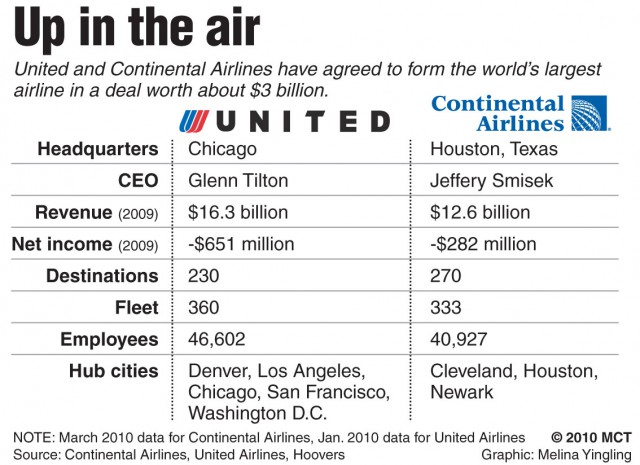CHICAGO — United Airlines and Continental Airlines announced early Monday morning they were combining operations in a $3-billion merger, forming the world’s largest airline.
The deal is the culmination of a lengthy search by United CEO Glenn Tilton
for a partner that would bolster his carrier’s global network and
promote consolidation in a fragmented industry plagued by chronic
losses.
The combined airline would have annual revenue of $29 billion, based on 2009 results, and hold an unrestricted cash balance of about $7.4 billion. The carriers said in a press release Monday they expected to complete the transaction in the fourth quarter of 2010.
Continental Chief Executive Jeff Smisek
will be named CEO of the new carrier, while Tilton will move to its
board as non-executive chairman for a two-year term. The new airline,
to be named United, will retain its world headquarters in Chicago, where United currently employs about 700 people, sources say.
Its aircraft will bear Continental’s globe logo on the tail and be painted in the Houston-based carrier’s colors. And it will be unveiled to customers with a new campaign, “Let’s Fly Together.”
Headquarters for the new United operations will be in Chicago’s Willis Tower, formerly known as the Sears Tower. United will move forward with plans to place its nerve center and 2,800 staffers in the skyscraper starting in October, sources said.
Unlike the earlier merger that United had contemplated with US Airways, this deal isn’t expected to involve large-scale cuts since United’s and Continental’s networks have little overlap. The carriers expect to continue serving the 370 cities where United or Continental currently fly and will operate 10 hubs, including bases in the four largest cities in the U.S.
Executives hope that linking Continental’s strong Latin American and European routes to United’s connections in Asia will generate a surge of new international traffic and revenues.
Executives expect to save $200 million to $300 million
annually by 2013 by reducing overhead and overlapping administrative
functions. The carriers said the effect on front-line workers would be
minimal, with job cuts coming primarily from retirement, attrition and
voluntary exits.
However, the carrier is expected to retain a significant presence in Houston, where Continental is headquartered, sources say. City and government leaders had petitioned executives at Continental and United to consider placing headquarters for the combined carrier in the southern Texas metropolis.
Houston will become the largest hub for the new carrier, bypassing United’s longstanding fortress hub at Chicago’s O’Hare International Airport. Smisek will have offices in both cities, the airlines said.
As anticipated, Continental shareholders will receive 1.05 shares of United’s stock in the all-stock deal, which will be structured as a merger of equals. As a result, United will control 55 percent of the company to Continental’s 45 percent.
The new airline will be governed by a 16-person
board, which will include two union representatives and six independent
directors, a source said.
Unions representing pilots, ramp workers and flight
attendants cautioned Monday morning that the merger’s success also will
depend on how quickly the new carrier can form new
collective-bargaining agreements with its workers.
———
(c) 2010, Chicago Tribune.
Visit the Chicago Tribune on the Internet at http://www.chicago.tribune.com
Distributed by McClatchy-Tribune Information Services.















